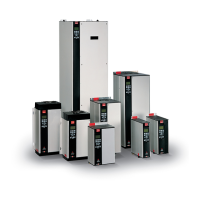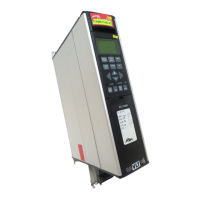4-3
VLT is a registered Danfoss trademark
Control Logic Problems
Problems with control logic can often be difficult to diagnose,
since there is usually no associated fault indication. The typical
complaint is simply that the drive does not respond to a given
command. There are two basic commands that must be given
to any drive in order to obtain an output. First, the drive must
be told to run (start command). Second, the drive must be
told how fast to run (reference or speed command).
The drives are designed to accept a variety of signals. First
determine what types of signals the drive is receiving. There
are eight digital inputs (terminals 16, 17, 18, 19, 20, 27, 29,
32, 33), three analog inputs (53, 54, 60), and the serial
communication bus (68, 69). The presence of a correct reading
will indicate that the desired signal has been detected by the
microprocessor of the drive. See Drive Inputs and Outputs in
Section 1.
Using the status information displayed by the drive is the best
method of locating problems of this nature. By changing
parameter 009 (VLT 5000) or parameter 007 (VLT 4000/6000/
8000), line 2 of the display can be set to indicate the signals
coming in. The presence of a correct reading indicates that
the desired signal is detected by the microprocessor of the
drive.
If there is not a correct indication, the next step is to determine
whether the signal is present at the input terminals of the drive.
This can be performed with a voltmeter or oscilloscope in
accordance with the 5.2.14, Input Terminal Signal Test.
If the signal is present at the terminal, the control card is
defective and must be replaced. If the signal is not present,
the problem is external to the drive. The circuitry providing the
signal along with its associated wiring must then be checked.
Programming Problems
Difficulty with drive operation can be a result of improper
programming of the drive parameters. Three areas where
programming errors may affect drive and motor operation are
motor settings, references and limits, and I/O configuration.
See Drive Inputs and Outputs in Section 1.
The drive must be setup correctly for the motor(s) connected
to it. Parameters 102 – 106 must have data from the motor
nameplate entered into the drive. This enables the drive
processor to match the drive to power characteristics of the
motor. The most common result of inaccurate motor data is
the motor drawing higher than normal amounts of current to
perform the task expected of it. In such cases, setting the
correct values to these parameters and performing the
automatic motor adaptation (AMA) function will usually solve
the problem.
Any references or limits set incorrectly will result in less than
acceptable drive performance. For instance, if maximum
reference is set too low, the motor will be unable to reach full
speed. These parameters must be set according to the
requirements of the particular installation. References are set
in the 200s parameter group.
Incorrectly set I/O configuration usually results in the drive not
responding to the function as commanded. It must be
remembered that for every control terminal input or output
there are corresponding parameters settings. These determine
how the drive responds to an input signal or the type of signal
present at that output. Utilizing an I/O function must be thought
of as a two step process. The desired I/O terminal must be
wired properly, and the corresponding parameter must be set
accordingly. Control terminals are programmed in the 300s
parameter group.
Motor/Load Problems
Problems with the motor, motor wiring or mechanical load on
the motor can develop in a number of ways. The motor or
motor wiring can develop a phase-to-phase or phase-to-
ground short resulting in an alarm indication. Checks must be
made to determine whether the problem is in the motor wiring
or the motor itself.
A motor with unbalanced, or non-symmetrical, impedances
on all three phases can result in uneven or rough operation, or
unbalanced output currents. Measurements should be made
with a clamp-on style ammeter to determine whether the
current is balanced on the three output phases. See 5.2.8,
Output Phase Imbalance Test procedure.
An incorrect mechanical load will usually be indicated by a
torque limit alarm or warning. Disconnecting the motor from
the load, if possible, can determine if this is the case.
Quite often, the indications of motor problems are similar to
those of a defect in the drive itself. To determine whether the
problem is internal or external to the drive, disconnect the
motor from the drive output terminals. Perform the output phase
imbalance test procedure (5.2.8) on all three phases with an
analog voltmeter. If the three voltage measurements are
balanced, the drive is functioning correctly. The problem
therefore is external to the drive.
If the voltage measurements are not balanced, the drive is
malfunctioning. This typically means that one or more output
IGBT is not switching on and off correctly. This can be a result
of a defective IGBT or gate signal from the gate driver card.
Perform the IGBT gate signal test (5.2.9).

